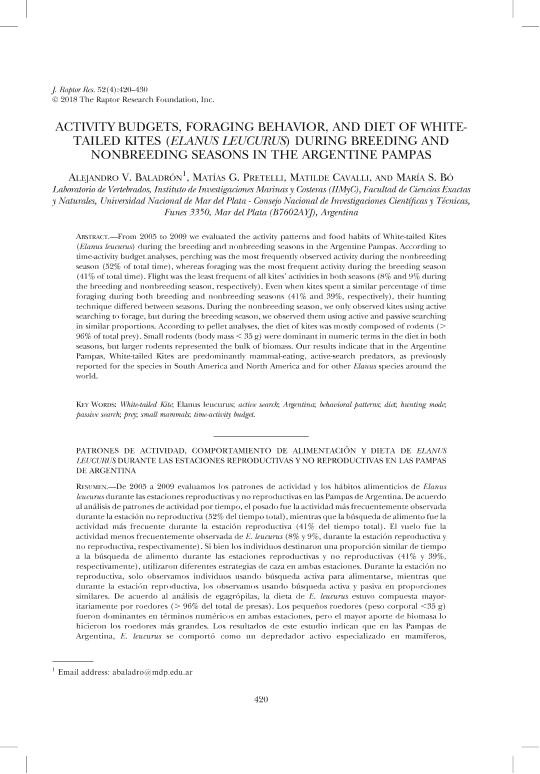Artículo
Activity Budgets, Foraging Behavior, and Diet of White-Tailed Kites (Elanus leucurus) during Breeding and Nonbreeding Seasons in the Argentine Pampas
Fecha de publicación:
12/2018
Editorial:
Raptor Research Foundation
Revista:
Journal of Raptor Research
ISSN:
0892-1016
Idioma:
Inglés
Tipo de recurso:
Artículo publicado
Clasificación temática:
Resumen
From 2005 to 2009 we evaluated the activity patterns and food habits of White-tailed Kites (Elanus leucurus) during the breeding and nonbreeding seasons in the Argentine Pampas. According to time-activity budget analyses, perching was the most frequently observed activity during the nonbreeding season (52% of total time), whereas foraging was the most frequent activity during the breeding season (41% of total time). Flight was the least frequent of all kites' activities in both seasons (8% and 9% during the breeding and nonbreeding season, respectively). Even when kites spent a similar percentage of time foraging during both breeding and nonbreeding seasons (41% and 39%, respectively), their hunting technique differed between seasons. During the nonbreeding season, we only observed kites using active searching to forage, but during the breeding season, we observed them using active and passive searching in similar proportions. According to pellet analyses, the diet of kites was mostly composed of rodents (> 96% of total prey). Small rodents (body mass < 35 g) were dominant in numeric terms in the diet in both seasons, but larger rodents represented the bulk of biomass. Our results indicate that in the Argentine Pampas, White-tailed Kites are predominantly mammal-eating, active-search predators, as previously reported for the species in South America and North America and for other Elanus species around the world.
Archivos asociados
Licencia
Identificadores
Colecciones
Articulos(IIMYC)
Articulos de INSTITUTO DE INVESTIGACIONES MARINAS Y COSTERAS
Articulos de INSTITUTO DE INVESTIGACIONES MARINAS Y COSTERAS
Citación
Baladrón, Alejandro V.; Pretelli, Matías Guillermo; Cavalli, Matilde; Bó, Maria Susana; Activity Budgets, Foraging Behavior, and Diet of White-Tailed Kites (Elanus leucurus) during Breeding and Nonbreeding Seasons in the Argentine Pampas; Raptor Research Foundation; Journal of Raptor Research; 52; 4; 12-2018; 420-430
Compartir
Altmétricas




